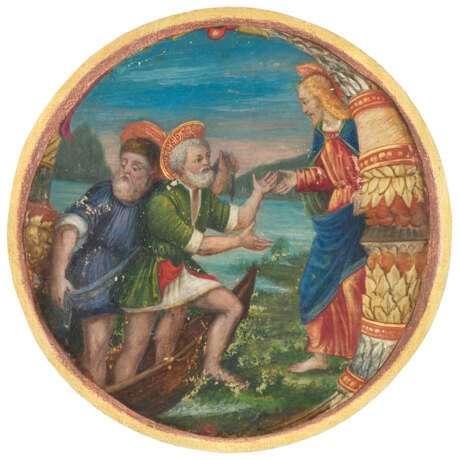ID 1249854
Lot 19 | Circle of Vincent Raymond
Estimate value
£ 7 000 – 10 000
The Calling of Sts Peter and Andrew, miniature cut from an illuminated choirbook on vellum [Rome, mid-15th century]
A vibrant illumination by an accomplished artist working in the circle of one of the most important illuminators of the 16th-century papal court, Vincent Raymond.
Cut in a circle, 132mm diameter, the miniature likely in an initial 'D' probably opening the introit for the Vigil of St Andrew (29 November), 'Dominus secus mare galilee vidit duos fratres Petri et Andream', reverse with two partial lines of text and music on a four-line red stave (a few small losses of pigment, e.g. to the robes of Peter, Andrew and Christ, to the boat, and to the foliage in the foreground, but generally in good condition). Pasted on paper. Provenance: Bonhams, 15 April 2021, lot 214.
The miniature, with its soft colours and mannerist composition, is the work of an extremely accomplished artist working in the circle of Vincent Raymond, one of the most important illuminators at the papal court during the 1500s, and the only one who was given an official status. Raymond was probably born in Lodève in Languedoc, but by 1535 he was working in Rome (see W.M. Voelkle and R.S. Wieck, The Bernard H. Breslauer Collection of Manuscript Illuminations, 1992, pp.224-27, no 90; R.S. Wieck, ‘Folia Fugitiva: The Pursuit of the Illuminated Manuscript Leaf’, The Journal of the Walters Art Gallery, LIV, 1996, p.238 and fig.9; S. Hindman et al., Manuscript Illumination in the Modern Age, 2002, p.57; and S. Panayotova in P. Binski and S. Panayotova, eds., The Cambridge Illuminations, 2005, pp.158-9, no 65, all with further references). He is the only illuminator to be mentioned in Vatican records from 1535 to 1549, the year he was named papal illuminator by Paul III (the only illuminator ever to have held this post). His other patrons included Leo X and Clement VII. Raymond's art has close connections with the most famous and fashionable Roman painting in large scale of the period, especially that of Michelangelo.
| Place of origin: | Italy, Europe |
|---|---|
| Auction house category: | Medieval & renaissance manuscripts, Books and manuscripts |
| Place of origin: | Italy, Europe |
|---|---|
| Auction house category: | Medieval & renaissance manuscripts, Books and manuscripts |
| Address of auction |
CHRISTIE'S 8 King Street, St. James's SW1Y 6QT London United Kingdom | |
|---|---|---|
| Preview |
| |
| Phone | +44 (0)20 7839 9060 | |
| Buyer Premium | see on Website | |
| Conditions of purchase | Conditions of purchase |



